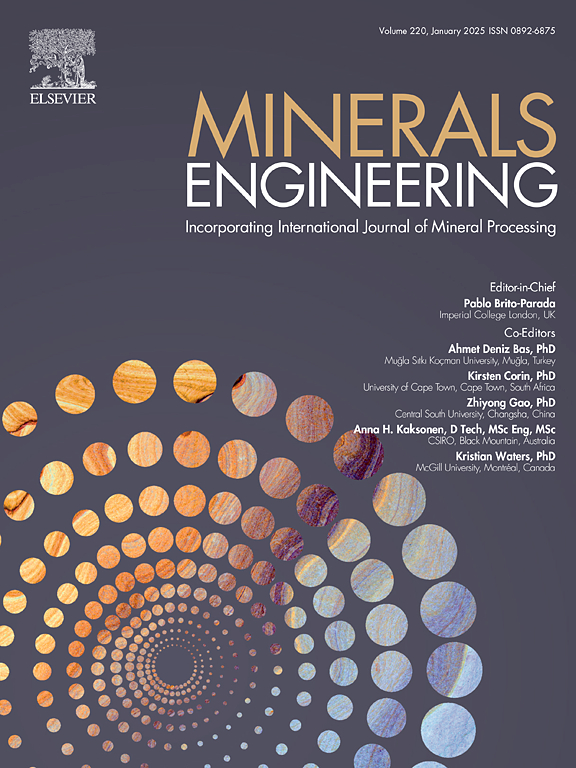Selective flotation separation of smithsonite and calcite using sodium dodecyl phosphonate as a collector: Flotation performance and adsorption characteristics
IF 4.9
2区 工程技术
Q1 ENGINEERING, CHEMICAL
引用次数: 0
Abstract
Smithsonite stands as a representative zinc oxide ore and is frequently found co − occurring with calcite. These two minerals possess similar physical and chemical characteristics, which consequently pose difficulties in their separation. To tackle the problem of separating smithsonite from calcite, this research employs sodium dodecyl phosphinate (NaDDP) as an effective and eco − friendly collector for the selective flotation of smithsonite and calcite. The obtained zinc concentrate features a Zn grade of 42.97 % and a recovery rate of 93.65 %, along with a Ca grade of 6.10 % and a recovery rate of 12.51 %, achieving an efficient flotation separation of the two minerals. Total Organic Carbon (TOC) analysis and Inductively Coupled Plasma (ICP) spectrometry reveal that a substantial amount of NaDDP is consumed by the Ca2+ released from calcite, leading to a restricted effective adsorption capacity of the reagent on the mineral surface. Nevertheless, the solubility of smithsonite is lower than that of calcite, and the quantity of NaDDP consumed in the solution is small, whereas the amount of the reagent adsorbed on the mineral surface is large. X-ray Photoelectron Spectroscopy (XPS), Zeta potential, time − of − flight secondary ion mass spectrometry (ToF − SIMS), and Density Functional Theory (DFT) calculation and analysis demonstrate that the interaction ability of NaDDP with Zn sites is stronger than that with Ca sites. When both are present at the same time, NaDDP reacts preferentially with Zn. This gives rise to adsorption differences between the two minerals for this reagent, resulting in variations in flotation behavior.
十二烷基膦酸钠作为捕收剂选择性浮选分离菱锌矿和方解石:浮选性能和吸附特性
史密森矿是一种典型的氧化锌矿石,常与方解石共生。这两种矿物具有相似的物理和化学特性,因此给它们的分离带来了困难。为了解决方解石和菱锌矿的分离问题,本研究采用十二烷基膦酸钠(NaDDP)作为一种高效的生态捕收剂,对菱锌矿和方解石进行选择性浮选。获得的锌精矿锌品位为42.97%,回收率为93.65%,钙品位为6.10%,回收率为12.51%,实现了两种矿物的有效浮选分离。总有机碳(TOC)分析和电感耦合等离子体(ICP)光谱分析表明,大量的NaDDP被方解石释放的Ca2+消耗,导致试剂在矿物表面的有效吸附能力受到限制。但smithsonite的溶解度低于方解石,溶液中消耗的NaDDP量较少,而在矿物表面吸附的试剂量较大。x射线光电子能谱(XPS)、Zeta电位、飞行时间二次离子质谱(ToF - SIMS)和密度泛函理论(DFT)计算和分析表明,NaDDP与Zn位点的相互作用能力比与Ca位点的相互作用强。当两者同时存在时,NaDDP优先与Zn反应。这就引起了两种矿物对该试剂的吸附差异,从而导致浮选行为的变化。
本文章由计算机程序翻译,如有差异,请以英文原文为准。
求助全文
约1分钟内获得全文
求助全文
来源期刊

Minerals Engineering
工程技术-工程:化工
CiteScore
8.70
自引率
18.80%
发文量
519
审稿时长
81 days
期刊介绍:
The purpose of the journal is to provide for the rapid publication of topical papers featuring the latest developments in the allied fields of mineral processing and extractive metallurgy. Its wide ranging coverage of research and practical (operating) topics includes physical separation methods, such as comminution, flotation concentration and dewatering, chemical methods such as bio-, hydro-, and electro-metallurgy, analytical techniques, process control, simulation and instrumentation, and mineralogical aspects of processing. Environmental issues, particularly those pertaining to sustainable development, will also be strongly covered.
 求助内容:
求助内容: 应助结果提醒方式:
应助结果提醒方式:


